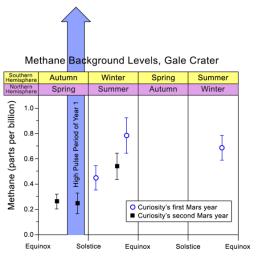Methane Background Levels at Gale Crater, Mars
Caption:
By repeated measurements of the concentration of methane in the atmosphere at Gale Crater, NASA's Curiosity Mars rover has detected long-term variation in background levels below one part per billion, much lower than a previously reported spike in methane. Researchers measure the methane concentration using the tunable laser spectrometer in the rover's Sample Analysis at Mars (SAM) suite of instruments.
The one-time spike in methane, up to about 7 parts per billion, by volume, was measured over a period of several weeks during late 2013 and early 2014, in the first Martian southern-hemisphere autumn (northern-hemisphere spring) of Curiosity's investigations. This spike was not repeated during Curiosity's second Mars year. Researchers plan to continue making methane measurements to ascertain whether variations in the background level of methane follow a seasonal pattern. The background level has ranged from about 0.2 parts per billion to about 0.8 parts per billion, generally lower in southern-hemisphere autumn (northern-hemisphere spring) than other seasons.
Methane can be produced either by biological processes or by non-biological processes, such as interaction of water with some types of rocks. Seasonal variations in concentration would suggest seasonal variation either in how methane is being put into the atmosphere or how it is being removed from the atmosphere, or both. A graphic of possible ways for adding and removing methane is at
http://mars.nasa.gov/msl/multimedia/images/?ImageID=6891
.
Background Info:
Development of SAM was coordinated by NASA's Goddard Space Flight Center, Greenbelt, Maryland. For more information on the SAM experiment, visit
http://ssed.gsfc.nasa.gov/sam/
. The tunable laser spectrometer for SAM was developed at NASA's Jet Propulsion Laboratory, Pasadena, California. This technology is also being tested for use on Earth as utility-company safety equipment to check for leaks in pipelines carrying natural gas. See
http://www.jpl.nasa.gov/news/news.php?feature=6192
for more information.
NASA's Jet Propulsion Laboratory, a division of the California Institute of Technology, Pasadena, manages the Mars Science Laboratory Project for NASA's Science Mission Directorate, Washington. JPL designed and built the project's Curiosity rover. For more information about Curiosity, visit
http://www.nasa.gov/msl
and
http://mars.jpl.nasa.gov/msl
.
Cataloging Keywords:
| Name |
Value |
Additional Values |
| Target |
Mars |
|
| System |
|
|
| Target Type |
Planet |
|
| Mission |
Mars Science Laboratory (MSL) |
|
| Instrument Host |
Curiosity Rover |
|
| Host Type |
Rover |
|
| Instrument |
Sample Analysis at Mars (SAM) |
|
| Detector |
|
|
| Extra Keywords |
Atmosphere, Color, Crater, Methane, Water |
| Acquisition Date |
|
| Release Date |
2016-05-11 |
| Date in Caption |
|
|
| Image Credit |
NASA/JPL-Caltech |
| Source |
photojournal.jpl.nasa.gov/catalog/PIA20601 |
| Identifier |
PIA20601 |

 Planetary Data System
Planetary Data System
